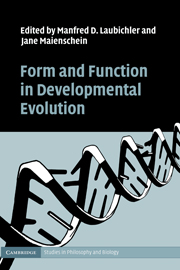Book contents
- Frontmatter
- Contents
- List of figures
- List of tables
- List of contributors
- List of journal abbreviations
- 1 Introduction
- 2 Form and function in Evo Devo: historical and conceptual reflections
- 3 Deducing plant function from organic form: challenges and pitfalls
- 4 Evolution in the light of embryos: seeking the origins of novelties in ontogeny
- 5 A focus on both form and function in examining selection versus constraint
- 6 Innovation and diversity in functional morphology
- 7 The developmental evolution of avian digit homology: an update
- 8 Functional analysis and character transformation
- 9 The nature of constraints
- 10 Toward a mechanistic Evo Devo
- Index
- References
2 - Form and function in Evo Devo: historical and conceptual reflections
Published online by Cambridge University Press: 28 June 2009
- Frontmatter
- Contents
- List of figures
- List of tables
- List of contributors
- List of journal abbreviations
- 1 Introduction
- 2 Form and function in Evo Devo: historical and conceptual reflections
- 3 Deducing plant function from organic form: challenges and pitfalls
- 4 Evolution in the light of embryos: seeking the origins of novelties in ontogeny
- 5 A focus on both form and function in examining selection versus constraint
- 6 Innovation and diversity in functional morphology
- 7 The developmental evolution of avian digit homology: an update
- 8 Functional analysis and character transformation
- 9 The nature of constraints
- 10 Toward a mechanistic Evo Devo
- Index
- References
Summary
The success of grand historical narratives and conceptual reflections rests, in no small part, on the selection of their central characters and features. If, as in our case here, the focus is on the development and integration of those ideas that have shaped our understanding of the living world, it is hardly possible to think of one pair of concepts more appropriate to structure a longue durée narrative than form and function. These linked concepts are uniquely suited to organizing the rich diversity and idiosyncratic developments within the history and philosophy of the life sciences in general, and within evolutionary developmental biology in particular.
The concepts of form and function, and everything connected to them, have been used as an organizing principle in several influential analyses of the development of the biological sciences. Their symbiotic and often dialectic relationship forms the backbone of such treatises as Ernst Mayr's The Growth of Biological Thought, William Coleman's Biology in the Nineteenth Century, Ernst Cassirer's Theory of Knowledge (specifically the section on the biological sciences), Edmund Beecher Wilson's The Cell in Development and Heredity, and, of course, Edward Stuart Russell's Form and Function: A Contribution to the History of Animal Morphology (Cassirer 1950; Coleman 1971; Mayr 1982; Russell 1916; Wilson 1925).
Information
- Type
- Chapter
- Information
- Form and Function in Developmental Evolution , pp. 10 - 46Publisher: Cambridge University PressPrint publication year: 2009
References
Accessibility standard: Unknown
Why this information is here
This section outlines the accessibility features of this content - including support for screen readers, full keyboard navigation and high-contrast display options. This may not be relevant for you.Accessibility Information
- 15
- Cited by
